Dark Era of the Mughal Empire
Babur and Humayun
Babur’s Conquest and Religious Intolerance

Babur, the founder of the Mughal Empire, secured his rule after the Battle of Panipat in 1526. Although his reign was praised for military success and for creating a new dynasty, it also marked systematic aggression against non-Muslims. In his memoirs, the Baburnama, Babur expresses disdain for Hinduism, especially its temples and idols. Furthermore, his campaigns often targeted these religious structures, symbolizing Islamic dominance.
Humayun’s Religious Coercion
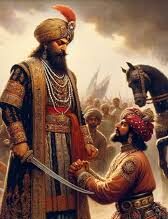
Humayun, the son of Babur, struggled to maintain control over the empire. While in exile in Persia, he adopted some Shia practices. Upon returning to India, he tried to impose these practices. However, his reign was characterized more by political instability than religious oppression. Nevertheless, his period set a precedent for future Mughal rulers. They began viewing the subjugation of non-Muslim populations as a means to consolidate power.
Akbar
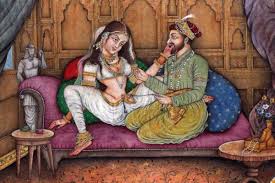
Mughal's Siege of Chittorgarh
The siege and massacre at Chittorgarh in 1567 marked a dark moment in Akbar’s reign. After capturing the fort, Akbar ordered the killing of over 30,000 civilians, mostly Hindus, seeking refuge there. This brutal act was part of a larger strategy to intimidate and suppress Rajput’s resistance to Mughal rule.
Cultural Imposition via the Din-i Ilahi
Akbar introduced the Din-i Ilahi, a syncretic religious movement, to centralize religious authority around himself. Although the movement attracted few followers and was short-lived, it reflected Akbar’s broader ambitions. His aim was to control the religious and cultural life of his empire. However, this often came at the expense of traditional Hindu and Jain practices.
Religious persecution and forced conversions by the Mughals
Akbar is often praised for his religious tolerance and the introduction of Sulh-i-Kul, meaning peace with all. However, this view of tolerance is challenged by instances of religious persecution during his reign. For example, while Akbar engaged in diplomacy with Hindu kings and abolished the jizya tax, his actions against Rajput kingdoms tell a different story. In these campaigns, he was known for the brutal massacre of thousands of non-combatants. Furthermore, prisoners were often forced to convert to Islam, complicating his legacy of tolerance.
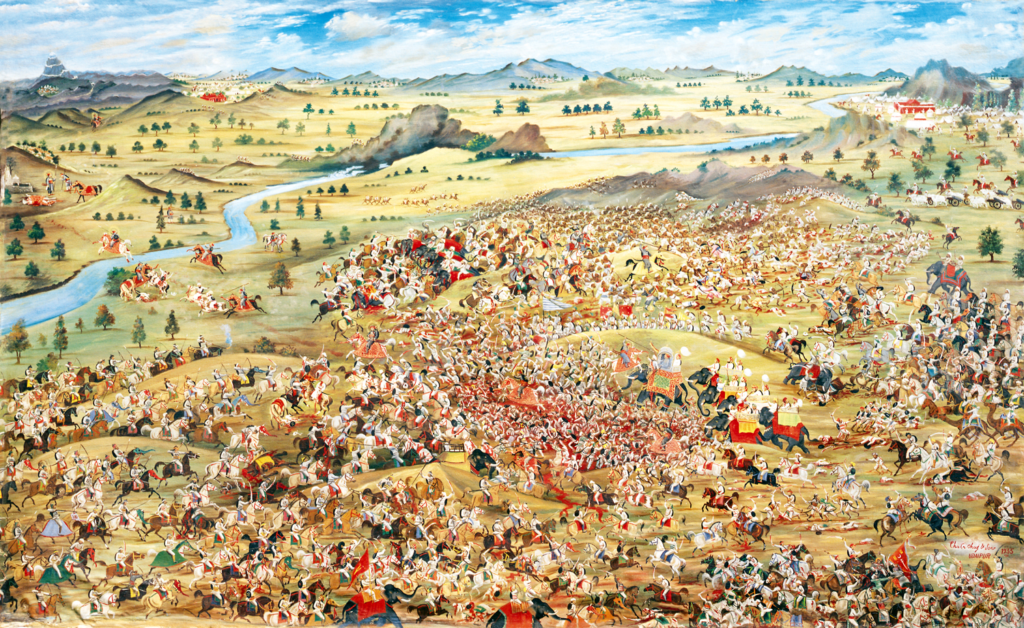
Jahangir and Shah Jahan
Jahangir’s Reign: Suppression of Sikhs and Hindus
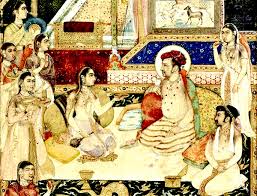
Jahangir’s reign is often remembered for cultural achievements but also for continued religious persecution. Notably, one significant act of repression was Guru Arjan Dev’s execution, the fifth Sikh Guru, in 1606. This tragic event marked the start of a long and violent conflict between the Sikh community and the Mughal state.
Shah Jahan: Majestic Architecture and Religious Intolerance
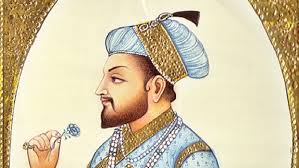
Shah Jahan is renowned for his architectural contributions, especially the Taj Mahal. However, his reign also featured the destruction of Hindu temples. Moreover, he imposed heavy taxes on non-Muslims. His campaigns in the Deccan region were particularly brutal. They involved desecrating temples and forcing captured soldiers and civilians to convert to Islam.
Aurangzeb

Persecution of the Sikh Gurus by the Mughal Emperor Aurangzeb
Aurangzeb’s persecution also targeted the Sikh community, with Guru Tegh Bahadur’s execution in 1675 being a notable example. After refusing to convert to Islam, Guru Tegh Bahadur was martyred in a brutal manner. As a result, his death strengthened the Sikh community’s resistance to Mughal rule. Eventually, this resistance led to the formation of the Khalsa under Guru Gobind Singh.
Destruction of Temples and Sacred Sites by the Mughals
His policy of temple destruction was systematic and widespread throughout his reign. For instance, he demolished the Kashi Vishwanath Temple in Varanasi. Additionally, the Krishna Janmabhoomi Temple in Mathura faced a similar fate. These actions were part of his broader plan to assert Islamic dominance. Consequently, they aimed to suppress Hindu religious practices across the empire.
Reinstatement of Jizya and Religious Oppression
Aurangzeb‘s reign is widely viewed as the harshest for non-Muslim communities under the Mughal Empire. In 1679, he reinstated the jizya tax, imposing a significant financial burden on Hindus. As a result, this tax became a symbol of their subjugation. Furthermore, Aurangzeb’s policies aimed to enforce Islamic law across the empire. Consequently, Hindus, Sikhs, and Jains faced widespread persecution during his rule.
Religious Persecution and Brutality of Mughal
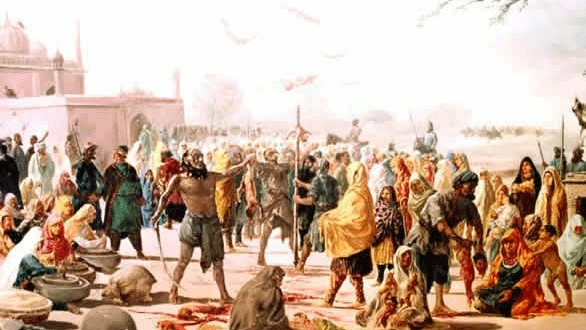
Massacres by Mughal Emperors
Amid religious conflicts and uprisings, Mughal forces committed gruesome massacres of non-Muslim men. Notably, one harrowing incident occurred during the Jats’ rebellion in Mathura in 1669. There, thousands of non-Muslim men faced a ruthless end.
Conversion Coercion
Throughout history, non-Muslims often faced the constant threat of forced conversion to Islam, imposed by various rulers. This practice reached its peak in both intensity and scale under the reign of Emperor Aurangzeb.
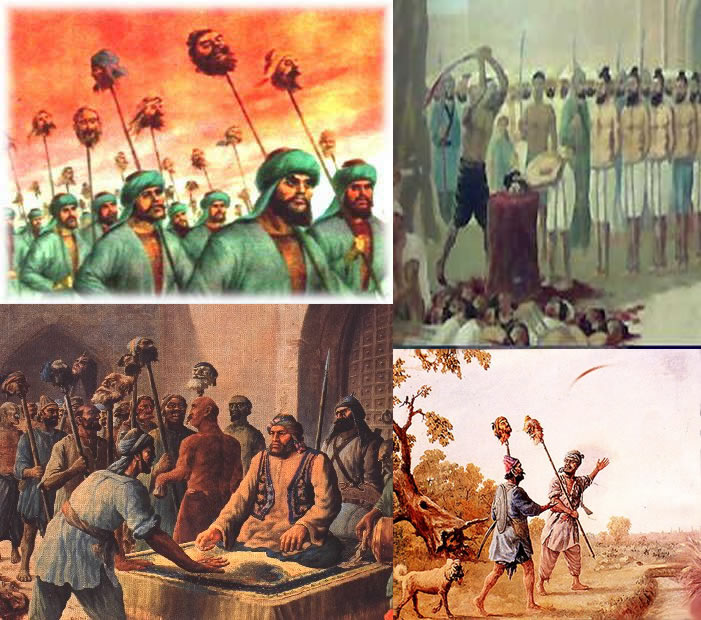
Enslavement of Non-Muslim Women by the Mughal
Non-Muslim women, particularly Hindus, were not spared from the horrors. Moreover, they faced abduction, enslavement, and forced marriages. These atrocities occurred during Mughal conquests and invasions.
Abduction and Enslavement
Non-Muslim women were often abducted, leading to lives of servitude. Consequently, they endured sexual exploitation and lived in constant fear.
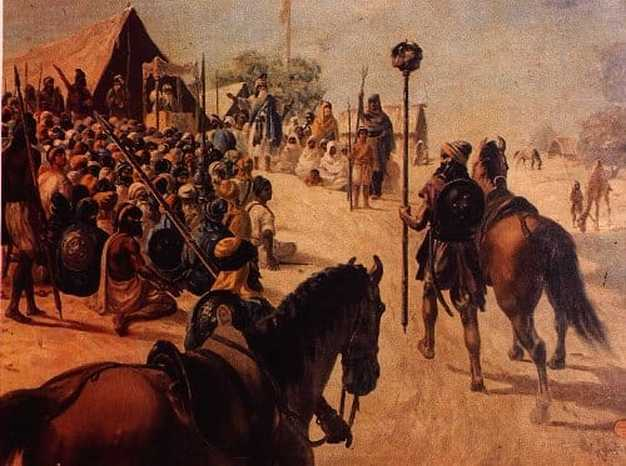
Mughal's Violence Against Non-Muslim
Non-Muslim men faced the worst of the brutality inflicted by the Mughals. Consequently, massacres and excruciating torture became tragically common.
Forced Marriages
Many non-Muslim women were forcibly married to Mughal soldiers. Consequently, they faced a life of subjugation. This situation led to immense suffering for them.
Mughal's Torture
The torturous methods used by the Mughals to extract wealth from non-Muslims were horrifying. Consequently, many faced agonizing torment. In particular, brutal limb mutilation was common.
Mughal's Cruelty on Sikhs
Guru Arjan Dev Ji, Guru Tegh Bahadur Sahib Ji Execution by Mughals
The Mughal Empire’s reign of terror affected the Sikh community significantly. For instance, Guru Arjan Dev Ji faced a harrowing fate under Emperor Jahangir. Jahangir, fearing Guru Arjan’s growing influence, ordered his execution. Despite attempts to spare him, the execution went ahead.
Similarly, Guru Tegh Bahadur Sahib Ji opposed the religious oppression from Emperor Aurangzeb. His courageous stand for religious freedom and ultimate sacrifice earned him the title “Hind Di Chadar” (The Shield of India).
Moreover, the accounts of Bhai Sati Das, Bhai Mati Das, Bhai Dayala, and Bhai Taru Singh Ji showcase the Sikh community’s unwavering faith. Their resilience exemplifies the strength of the Sikh spirit in the face of brutal persecution.
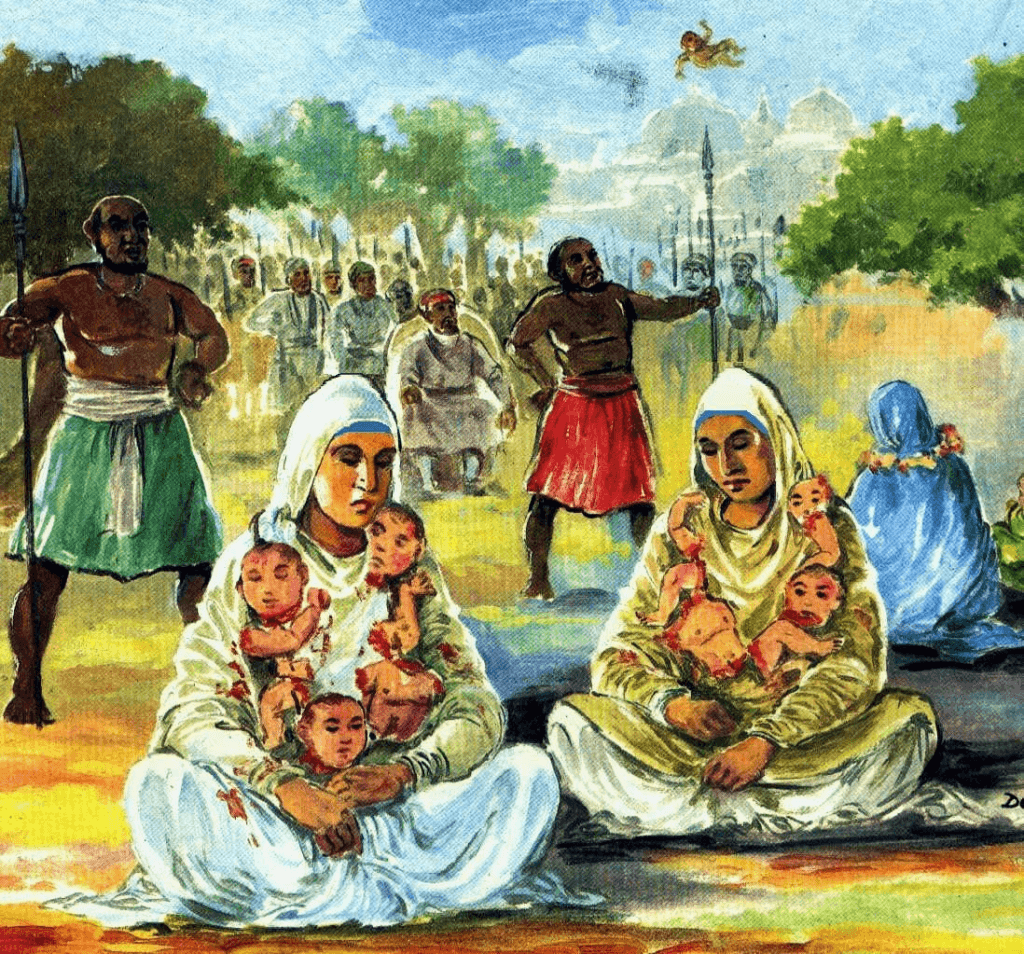
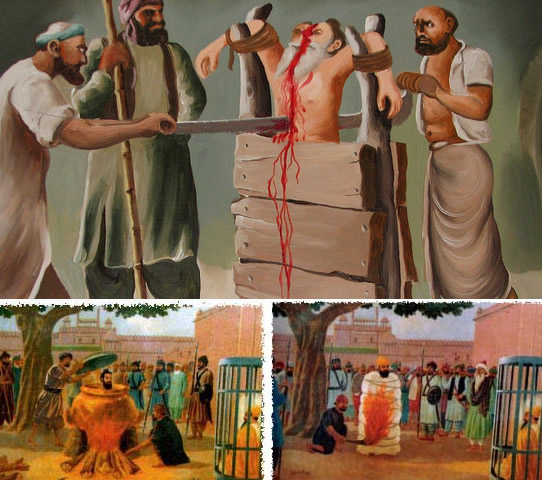
Mass Torture and Persecution by the Mughal
Zakariya Khan, the Mughal governor of Lahore, unleashed a reign of terror against the Sikh population. As a result, he ordered the capture of Sikhs, leading to widespread violence. Moreover, prominent Sikhs, including Bhai Mani Singh, faced torture and execution.
Mughal Violence on Sikh Women and Children
During the 18th century, Sikh women were imprisoned in Mir Mannu’s Jail in Lahore. They endured unimaginable hardships. Despite the horrific pain of losing their children, who were murdered and made into garlands, these women maintained their faith. Additionally, their resilience remained unbroken throughout their suffering.
References
Singh, K. (1963). A History of the Sikhs. Princeton: Princeton University Press.
Alam, M. (1998). The Crisis of Empire in Mughal North India. Delhi: Oxford University Press.
Asher, C. B. (1992). Architecture of Mughal India. Cambridge: Cambridge University Press.
Brown, K. (1994). Humayun. London: Oneworld.
Eaton, R. M. (2000). Temple Desecration and Muslim States in Medieval India. Oxford University Press.
Eraly, A. (1997). The Mughal Throne: The Saga of India’s Great Emperors. London: Phoenix Press.
Grewal, J. S. (1998). The Sikhs of the Punjab. Cambridge: Cambridge University Press.
Habib, I. (1981). Akbar and His India. Delhi: Oxford University Press.
Kulkarni, A. R. (2001). Maharashtra in the Age of Shivaji. Delhi: Oxford University Press.
Majumdar, R. C. (1974). The History and Culture of the Indian People. Mumbai: Bharatiya Vidya Bhavan.
Richards, J. F. (1995). The Mughal Empire. Cambridge: Cambridge University Press.
